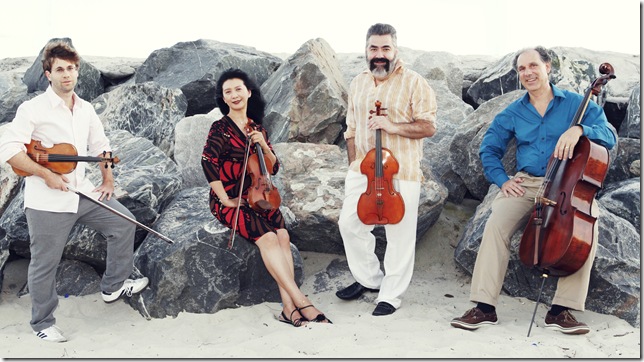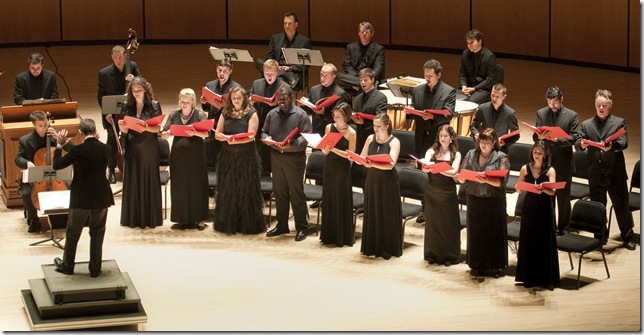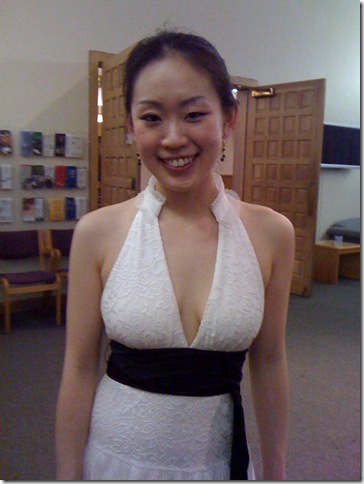Here are brief reviews from three recent concerts:
Delray String Quartet (Dec. 11, Colony Hotel, Delray Beach): This foursome is on something of a roll as it enters its eighth season of concertizing. Next month it will give the world premiere of the String Quartet No. 5 by Kenneth Fuchs, and will contribute that work to an all-Fuchs disc for Naxos.
It’s just released a second disc (a sampler of live performances from last season), and at the end of next year plans to offer a recording of the Grieg String Quartet and the Piano Quintet of Jean Sibelius, with pianist Tao Lin.
And with a new sponsorship from the Akerman Senterfitt law firm, the quartet is on the verge of a more muscular future. Last Sunday afternoon, it gave the last performance of its first program in a well-attended concert at the Colony Hotel in Delray Beach.
The guest for the afternoon was clarinetist Paul Green, who played the Clarinet Quintet (in B-flat, Op. 34) of Carl Maria von Weber. Clarinetists would be considerably worse off without Weber’s works for clarinet, and this piece is essentially a chamber concerto, with the strings mostly playing accompaniment as the clarinet leaps athletically over the soundscape.
Green played with alacrity and fluid technique, with plenty of impressive, pearly runs throughout the range of the instrument. The very top of the register was sometimes pinched and shrill, but he made up for that with a big, pretty tone in the slow movement.
The second half was devoted to the String Quartet No. 1 (in E minor) of Bedrich Smetana, titled From My Life. This is a repeat work for the Delrays, and this season it got a very well-drilled, solid performance, with good work from violist Richard Fleischman to get the piece off to an impassioned start. Cellist Claudio Jaffe played his yearning intro to the slow movement beautifully, and violinists Mei Mei Luo and Tomas Cotik played with force and vigor.
Although this was an impressive, accurate reading of this fine work of late Romanticism, overall it was perhaps played too aggressively. Each movement was hammered home, and though there were lovely spots of tenderness and contrast in moments such as the rustic Trio of the second movement, in general things were hard-edged and ferocious; it was effective and exciting, but rather too rough.
The concert closed with a very effective arrangement (by a Briton who goes by J. Nurse) of the overture to Franz Lehar’s The Merry Widow. It was strong enough to implant Vilja in one’s head for hours afterward, and it was a certified crowd pleaser Sunday.
It may be that this lineup of the quartet, with Cotik in his second season, will be the one to carry it to the next level. The group seems to have gotten past some of its earlier bumpiness and is starting to think of itself as an ensemble that can do bigger things than heretofore. This will be the season to watch for fans of the Delray String Quartet.
Seraphic Fire (Dec. 7, St. Gregory’s Episcopal Church, Boca Raton): There’s almost no end to the great corpus of old and new music for the Christmas season, and last week Seraphic Fire presented its usual eclectic mix of the fresh and familiar for its O Holy Night program of holiday fare.
The Miami concert choir learned earlier this month that it had been nominated for two Grammy Awards, one for its recording of the London version of the Brahms German Requiem, and the other for its first Christmas album (a second one is being done this month). A lot therefore is riding on this current season of concerts to cement that reputation, and so far, so good.
Prominent on the Dec. 7 program at St. Gregory’s, its new Boca Raton home, were new pieces by Steven Sametz and two fresh arrangements by Seraphic Fire founder Patrick Dupré Quigley. The Sametz piece, Nino de Rosas, from Three Mystical Choruses, is getting its Florida premiere in the Seraphic Fire concerts for Christmas, and it features the kind of pungent harmony and stark dramatic setting familiar from this composer’s other choral works. Soloist Lexa Ferrill, a mezzo-soprano, has a characterful quality to her singing, but there was a bit too much vibrato here for my taste, though the piece itself was compelling and well-crafted.
As usual with Seraphic Fire, Quigley made good use of the space, working by candlelight (and LEDs for the music books choristers carried) for the first segment, and bringing in his singers from the back of the church as they sang Preces and Responses by the 17th-century English composer William Smith. Between those two was Steven Paulus’ Hymn to the Eternal Flame, and after the Responses came Thomas Tallis’ Glory to Thee, My God, This Night, and Quigley’s adaptation of the David Willcocks arrangement of O Come, All Ye Faithful (with the famous descant intact).
All of the concert was like this, with songs done back to back in discrete sections. It had a wonderful way of making the music sound equally persuasive, especially sung this beautifully, with a smooth vocal sheen over everything and contemporary music handled as ably as that of the Renaissance, which was represented here by a lovely reading of Victoria’s O Magnum Mysterium.
Other standouts include a touching Little Child in a Manger, by the contemporary Canadian composer Stephen Chatman, and Seraphic Fire’s now-familiar treatment of Elizabeth Poston’s Jesus Christ the Apple Tree as a 13-part canon sung from throughout the nave by the choir members. Mezzo-soprano Misty Bermudez was the soloist in the closing O Holy Night, arranged by Quigley in a way that at first echoed the bare-bones sound of much of the music on the concert. Bermudez’s voice was rich and full, and Quigley ended his interesting arrangement unusually, in a blaze of fortissimo glory.
Yoonjung Han (Dec. 4, Steinway Gallery Boca Raton): Earlier this month, the South Korean-born pianist Yoonjung Han played the Dame Myra Hess memorial recital series in Chicago, a prestigious series that has introduced rising pianists to a Chicago-area audience in the hall and over WFMT radio.
Three days before, local audiences got to hear Han’s work at the Steinway Gallery in Boca Raton, a return appearance for her this year, after a recital at the Unitarian Universalist Church in Boca last season.
Han, who turns 27 next month, began with Federico Mompou’s Variations on a Theme of Chopin, in which the Catalan composer takes the little Prelude in A (Op. 28, No. 7) through a delicious set of reworkings. She played them beautifully, finding particular warmth in the fourth variation, with its langorous tonal language and sense of bittersweet melancholy.
She brought that same sensibility to more Spanish music, two of the Goyescas (Los requiebros and El amor y la muerte) of Enrique Granados, where even in the more extravagant pages Han had control of the music she was making, infusing it with a fine feeling for Spanish color. She was just as persuasive in the Godowsky reworking of Albéniz’s Tango in D, from his España (Op. 165).
Han also played the Beethoven Sonata No. 28 (in A, Op. 101), which came off a shade carefully. Her Classical textures are very clear and clean, particularly in the fugal passages of the finale. While the short slow movement was darkly pretty, the preceding March needed a bit more abandon, some more force and Beethoven-style coarse wit. That would have made a stronger contrast with the discursiveness of the opening movement and given the music more shape.
Still, this was highly attractive playing, and she returned to the same tradition with pleasing effect in one of her encores, the slow movement of the big E-flat Sonata (No. 52, Hob.XVI: 52) of Haydn. She captured the fantasia element of this music admirably, with a wide range of nuance and shade, and a little rush in the descending thirds that brought the listener’s attention to bear on the music’s drama.
For her second and final encore, Han performed La Campanella, Liszt’s fiery etude on the theme from the finale of Paganini’s Violin Concerto No. 2. Han unleashed the fireworks for this piece, demonstrating not just excellent fingerwork but also that she has those virtuoso capabilities in her arsenal.
It was refreshing to get a good piece of bravura after a lot of introspection in Han’s program, and she seems partial to the dreamier, deeply Romantic part of the repertory. She makes a fine champion of Mompou and Spanish composers, but quite a good Classicist, too. When she comes back again, it’d be good to hear her do some earlier Haydn and Beethoven, perhaps even some Mozart, and to see whether she can bring the kind of depth she brought to Mompou to another side of her art.


